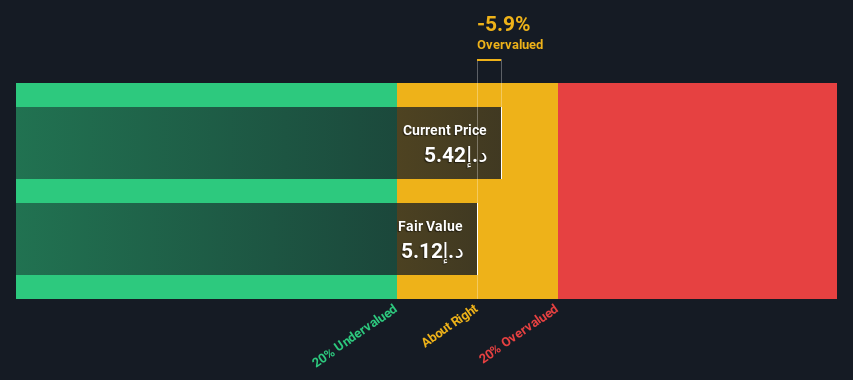Estimating The Intrinsic Value Of Emirates Integrated Telecommunications Company PJSC (DFM:DU)

Key Insights
- Emirates Integrated Telecommunications Company PJSC's estimated fair value is د.إ5.12 based on 2 Stage Free Cash Flow to Equity
- Emirates Integrated Telecommunications Company PJSC's د.إ5.42 share price indicates it is trading at similar levels as its fair value estimate
- Analyst price target for DU is د.إ6.59, which is 29% above our fair value estimate
Does the July share price for Emirates Integrated Telecommunications Company PJSC (DFM:DU) reflect what it's really worth? Today, we will estimate the stock's intrinsic value by projecting its future cash flows and then discounting them to today's value. This will be done using the Discounted Cash Flow (DCF) model. Models like these may appear beyond the comprehension of a lay person, but they're fairly easy to follow.
Companies can be valued in a lot of ways, so we would point out that a DCF is not perfect for every situation. For those who are keen learners of equity analysis, the Simply Wall St analysis model here may be something of interest to you.
See our latest analysis for Emirates Integrated Telecommunications Company PJSC
Is Emirates Integrated Telecommunications Company PJSC Fairly Valued?
We're using the 2-stage growth model, which simply means we take in account two stages of company's growth. In the initial period the company may have a higher growth rate and the second stage is usually assumed to have a stable growth rate. In the first stage we need to estimate the cash flows to the business over the next ten years. Where possible we use analyst estimates, but when these aren't available we extrapolate the previous free cash flow (FCF) from the last estimate or reported value. We assume companies with shrinking free cash flow will slow their rate of shrinkage, and that companies with growing free cash flow will see their growth rate slow, over this period. We do this to reflect that growth tends to slow more in the early years than it does in later years.
A DCF is all about the idea that a dollar in the future is less valuable than a dollar today, and so the sum of these future cash flows is then discounted to today's value:
10-year free cash flow (FCF) estimate
| 2024 | 2025 | 2026 | 2027 | 2028 | 2029 | 2030 | 2031 | 2032 | 2033 | |
| Levered FCF (AED, Millions) | د.إ1.62b | د.إ1.90b | د.إ1.82b | د.إ1.82b | د.إ1.86b | د.إ1.95b | د.إ2.06b | د.إ2.20b | د.إ2.37b | د.إ2.55b |
| Growth Rate Estimate Source | Analyst x3 | Analyst x2 | Analyst x1 | Est @ -0.11% | Est @ 2.62% | Est @ 4.53% | Est @ 5.87% | Est @ 6.80% | Est @ 7.46% | Est @ 7.92% |
| Present Value (AED, Millions) Discounted @ 14% | د.إ1.4k | د.إ1.5k | د.إ1.2k | د.إ1.1k | د.إ950 | د.إ868 | د.إ803 | د.إ750 | د.إ704 | د.إ664 |
("Est" = FCF growth rate estimated by Simply Wall St)
Present Value of 10-year Cash Flow (PVCF) = د.إ9.9b
After calculating the present value of future cash flows in the initial 10-year period, we need to calculate the Terminal Value, which accounts for all future cash flows beyond the first stage. For a number of reasons a very conservative growth rate is used that cannot exceed that of a country's GDP growth. In this case we have used the 5-year average of the 10-year government bond yield (9.0%) to estimate future growth. In the same way as with the 10-year 'growth' period, we discount future cash flows to today's value, using a cost of equity of 14%.
Terminal Value (TV)= FCF2033 × (1 + g) ÷ (r – g) = د.إ2.6b× (1 + 9.0%) ÷ (14%– 9.0%) = د.إ51b
Present Value of Terminal Value (PVTV)= TV / (1 + r)10= د.إ51b÷ ( 1 + 14%)10= د.إ13b
The total value, or equity value, is then the sum of the present value of the future cash flows, which in this case is د.إ23b. To get the intrinsic value per share, we divide this by the total number of shares outstanding. Compared to the current share price of د.إ5.4, the company appears around fair value at the time of writing. Valuations are imprecise instruments though, rather like a telescope - move a few degrees and end up in a different galaxy. Do keep this in mind.

The Assumptions
We would point out that the most important inputs to a discounted cash flow are the discount rate and of course the actual cash flows. Part of investing is coming up with your own evaluation of a company's future performance, so try the calculation yourself and check your own assumptions. The DCF also does not consider the possible cyclicality of an industry, or a company's future capital requirements, so it does not give a full picture of a company's potential performance. Given that we are looking at Emirates Integrated Telecommunications Company PJSC as potential shareholders, the cost of equity is used as the discount rate, rather than the cost of capital (or weighted average cost of capital, WACC) which accounts for debt. In this calculation we've used 14%, which is based on a levered beta of 0.800. Beta is a measure of a stock's volatility, compared to the market as a whole. We get our beta from the industry average beta of globally comparable companies, with an imposed limit between 0.8 and 2.0, which is a reasonable range for a stable business.
SWOT Analysis for Emirates Integrated Telecommunications Company PJSC
- Earnings growth over the past year exceeded the industry.
- Currently debt free.
- Dividend is low compared to the top 25% of dividend payers in the Telecom market.
- Expensive based on P/E ratio and estimated fair value.
- Annual earnings are forecast to grow faster than the Emirian market.
- Dividends are not covered by cash flow.
- Annual revenue is forecast to grow slower than the Emirian market.
Looking Ahead:
Although the valuation of a company is important, it shouldn't be the only metric you look at when researching a company. The DCF model is not a perfect stock valuation tool. Instead the best use for a DCF model is to test certain assumptions and theories to see if they would lead to the company being undervalued or overvalued. For instance, if the terminal value growth rate is adjusted slightly, it can dramatically alter the overall result. For Emirates Integrated Telecommunications Company PJSC, we've compiled three further aspects you should explore:
- Risks: To that end, you should be aware of the 1 warning sign we've spotted with Emirates Integrated Telecommunications Company PJSC .
- Future Earnings: How does DU's growth rate compare to its peers and the wider market? Dig deeper into the analyst consensus number for the upcoming years by interacting with our free analyst growth expectation chart.
- Other High Quality Alternatives: Do you like a good all-rounder? Explore our interactive list of high quality stocks to get an idea of what else is out there you may be missing!
PS. Simply Wall St updates its DCF calculation for every Emirian stock every day, so if you want to find the intrinsic value of any other stock just search here.
If you're looking to trade Emirates Integrated Telecommunications Company PJSC, open an account with the lowest-cost platform trusted by professionals, Interactive Brokers.
With clients in over 200 countries and territories, and access to 160 markets, IBKR lets you trade stocks, options, futures, forex, bonds and funds from a single integrated account.
Enjoy no hidden fees, no account minimums, and FX conversion rates as low as 0.03%, far better than what most brokers offer.
Sponsored ContentValuation is complex, but we're here to simplify it.
Discover if Emirates Integrated Telecommunications Company PJSC might be undervalued or overvalued with our detailed analysis, featuring fair value estimates, potential risks, dividends, insider trades, and its financial condition.
Access Free AnalysisHave feedback on this article? Concerned about the content? Get in touch with us directly. Alternatively, email editorial-team (at) simplywallst.com.
This article by Simply Wall St is general in nature. We provide commentary based on historical data and analyst forecasts only using an unbiased methodology and our articles are not intended to be financial advice. It does not constitute a recommendation to buy or sell any stock, and does not take account of your objectives, or your financial situation. We aim to bring you long-term focused analysis driven by fundamental data. Note that our analysis may not factor in the latest price-sensitive company announcements or qualitative material. Simply Wall St has no position in any stocks mentioned.
About DFM:DU
Emirates Integrated Telecommunications Company PJSC
Provides mobile, fixed services, broadband connectivity, and IPTV solutions to homes and businesses in the United Arab Emirates.
Outstanding track record with excellent balance sheet.


